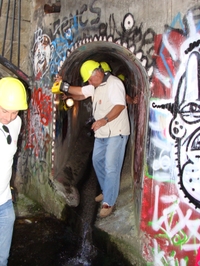Underworld art experience
by Rebecca Fitzgibbon
The Mercury
June 21, 2009
Hobart’s subterranean waterway has become a fresco of urban art.
 The unsanctioned art in the tunnels of the Hobart Rivulet has also become a tourist attraction.
The unsanctioned art in the tunnels of the Hobart Rivulet has also become a tourist attraction.
The rivulet is painted from one end to the other – an investment of time, paint and money, says artist Shaun McGowan.
His sculptural artwork in the rivulet was recently featured in advertising material for Hobart City Council’s Waterway Tours and the TV program Discover Tasmania.
An exhibiting artist of 20 years and former associate lecturer at the Centre for the Arts, McGowan has spent three days a week for the past year working on his rivulet installation.
He has attached plaster-cast doll heads to the underground Wellington Bridge, reminiscent of the catacombs of Paris, which are lined with the skulls of overflowing 17th-century cemeteries.
“I’d love to keep doing this project for years to come,” he said. “It’s the opposite of gallery and studio work. There’s no barrier around it saying that other people can’t contribute or break it or do whatever they like. I love that collaborative nature.
“The more permanent unsanctioned public art is adding to a cumulative history, right back to Aboriginal culture and art.”
McGowan’s installation is at the underground junction of the Wellington and Hobart rivulets, which he considers a sacred place akin to ancient cultural traditions, from Aboriginal to Celtic.
“We’ve put the mall over the top and ignored it. I think it’s as spiritual a space as the cathedral,” he said. “That’s why I’ve been working on it a long time and haven’t made a big splash about it. I see it as a spiritual place and I’m redeeming spiritual sites in the city.”
McGowan acknowledges concerns regarding the historical value of the bridge that is his canvas. The convict-built sandstone structure is one of the oldest bridges in Australia.
“Somebody has to make judgments about heritage. It’s a complex argument and every city needs to have that argument,” McGowan said. “The idea that you might suggest that this (unsanctioned artwork) is heritage is really getting on the goat of some people at the moment who are having legitimate trouble with graffiti.
“This drain is hundreds of years old and hopefully will be here for more hundreds of years. And people will add to that in their own way.
“In a couple of hundred years, anything that anyone’s done today will be seen as dreadfully important.”
Artwork added to the experience of visiting Hobart Rivulet’s tunnels, said Hobart City Council Waterway Tours guide Ian Byers.
“People are captivated by the urban artwork. People bring cameras along. Generally they’re pretty amazed, especially if it’s a good piece,” Mr Byers said. “As tour guides down there, we’ve come to appreciate – and some of the clients have too – how little graffiti is above ground around Hobart, because it’s all down in the rivulet.”
Mr Byers said the rivulet tours were taking longer because clients wanted to stop, look and talk about the sculptural piece.
“It’s really adding to the attraction. It’s something new, something different; I suppose part of the whole system of change,” he said.
Mr Byers believes there should be a book published on the changing face of the rivulet.
Fellow tour guide Susanna Van Essen said the rivulet was like an “urban art gallery where the exhibition is changing all the time”.
photo: abc.net.au
